Planting a garden in the ground is an art that can bring joy and abundance to gardening enthusiasts across the US. It’s a rewarding journey that allows you to connect with nature, cultivate your own food, and create a beautiful outdoor space. Whether you’re a beginner or an experienced gardener, mastering the art of planting a garden in the ground is essential for a successful and thriving garden.
Key Takeaways:
- Planting a garden in the ground is a fulfilling and rewarding experience.
- Mastering the art of ground planting is essential for a successful garden.
- By following proper techniques and using the right tools, you can create a beautiful and thriving garden.
- Soil preparation, plant selection, and maintenance are key factors for a successful garden in the ground.
- Embrace sustainable gardening practices, such as composting and organic fertilization, for a healthy and eco-friendly garden.
Ground Planting: A Gardening Method with Advantages
Ground planting offers numerous advantages over other gardening methods, such as container gardening or raised bed gardening. By planting directly in the ground, you can create a thriving garden with optimal growing conditions. In this section, we will explore the benefits of ground planting and provide tips for successful garden bed preparation and choosing the best location for your garden.
Benefits of Ground Planting
Ground planting provides a range of benefits that can contribute to the success of your garden. Firstly, planting in the ground allows for deeper root growth, which promotes healthier and more productive plants. The soil in the ground is rich in nutrients and provides a stable environment for plant roots to establish themselves.
Additionally, ground planting offers better water retention compared to other methods. The soil in the ground has a greater capacity to hold water, reducing the frequency of watering and ensuring consistent moisture for your plants.
Furthermore, ground planting allows for better nutrient absorption. The natural ecosystem in the soil promotes the breakdown of organic matter, releasing essential nutrients that can be readily absorbed by your plants. This results in healthier growth and higher yields.
Garden Bed Preparation
Proper garden bed preparation is crucial for successful ground planting. Start by clearing the area of any weeds, rocks, or debris that could impede plant growth. Loosen the soil with a garden fork or tiller, breaking up any compacted areas.
Next, incorporate organic matter into the soil to improve its structure and fertility. This can include compost, aged manure, or other organic amendments. Spread a layer of organic matter over the top of the soil and mix it in thoroughly.
Finally, level the garden bed and ensure it has good drainage. If the soil is too compacted, consider adding sand or perlite to improve drainage. Avoid planting in areas with standing water or poor drainage, as this can lead to root rot and other plant health issues.
Choosing the Best Location
When selecting the location for your ground garden, consider the sunlight requirements of your plants. Most vegetables and flowers require at least six to eight hours of direct sunlight per day. Observe the amount of sunlight different areas of your yard receive throughout the day and choose a location that meets the sunlight needs of your plants.
It’s also important to consider the proximity to water sources. Ensure your garden is within reach of a water hose or irrigation system for regular watering. Additionally, consider any nearby structures or trees that may cast shade on your garden, as this can affect plant growth.
Finally, think about convenience and accessibility. Choose a location that is easy to access and maintain. Consider factors such as proximity to your home, ease of watering, and any potential obstacles that may make gardening difficult.
Ground planting provides a range of benefits that can contribute to the success of your garden. Firstly, planting in the ground allows for deeper root growth, which promotes healthier and more productive plants.
Conclusion
Ground planting offers numerous advantages for successful gardening. By understanding the benefits and taking the time to prepare your garden bed and choose the best location, you can create a thriving garden in the ground. In the next section, we will explore the importance of soil preparation for a successful garden.
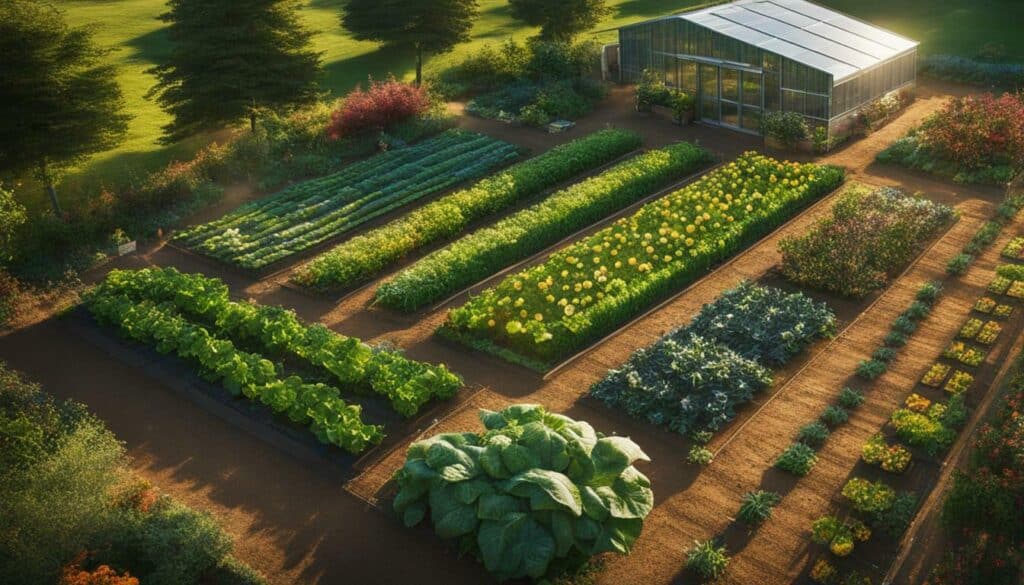
Soil Preparation for a Successful Garden
Before you start planting, it’s crucial to prepare the soil in your garden to create a nutrient-rich and well-draining environment for your plants. Proper soil preparation is the foundation for a successful garden, providing the necessary nutrients and support for healthy plant growth. Here are some essential steps to take when preparing your garden soil:
- Clear the area: Begin by removing any existing weeds, grass, or debris from the area where you plan to plant your garden. This will help eliminate competition for nutrients and ensure a clean growing space.
- Test the soil: Conduct a soil test to determine the pH level and nutrient content of your soil. This will help you identify any deficiencies or imbalances that need to be addressed. Soil testing kits are readily available at garden centers or through online suppliers.
- Amend the soil: Based on the results of your soil test, add organic matter such as compost, well-rotted manure, or peat moss to improve the soil structure and fertility. Organic matter helps retain moisture, promotes beneficial microbial activity, and provides essential nutrients for plant growth.
- Loosen the soil: Use a garden fork or tiller to loosen compacted soil. This will improve aeration, drainage, and root penetration. Avoid overworking the soil, as excessive tilling can disrupt the natural structure and microorganisms.
- Add nutrients: Incorporate organic fertilizers or amendments into the soil based on the specific needs of your plants. This may include nitrogen for leafy greens, phosphorus for root development, and potassium for overall plant health. Follow the recommended application rates and guidelines provided by the product manufacturer.
- Level the soil: Smooth out the soil surface using a rake or garden leveling tool. This will provide an even planting bed and prevent water from pooling in low spots.
“Proper soil preparation is the foundation for a successful garden, providing the necessary nutrients and support for healthy plant growth.”
By following these soil preparation steps, you can ensure that your garden soil is optimized for plant growth and productivity. Remember to regularly monitor and maintain the health of your soil throughout the growing season by incorporating organic matter, providing adequate moisture, and practicing proper crop rotation. With a well-prepared soil foundation, your plants will have the best chance to thrive and produce a bountiful harvest.
Selecting the Right Plants for Your Garden
The success of your garden depends on selecting the right plants that are well-suited to your specific growing conditions and preferences. With so many options available, it can be overwhelming to decide which plants to choose. Here are some tips to help you select the right plants for your garden:
- Consider your climate: Different plants thrive in different climates, so it’s important to choose plants that are well-suited to the climate in your area. Consider factors such as temperature, humidity, and rainfall when selecting plants for your garden.
- Assess sunlight requirements: Some plants require full sun, while others prefer partial shade. Take note of the sunlight conditions in your garden and choose plants that will thrive in those conditions.
- Think about space: Consider the size and layout of your garden when selecting plants. Choose plants that will fit comfortably in your garden beds or containers without overcrowding.
- Consider your soil type: Different plants have different soil requirements. Assess the type of soil in your garden, whether it is sandy, clay, or loamy, and choose plants that will thrive in that type of soil.
- Consider your gardening skills: If you’re a beginner gardener, choose plants that are easy to grow and low-maintenance. As you gain more experience, you can experiment with more challenging plants.
- Think about your preferences: Consider the colors, scents, and textures that you enjoy in a garden. Choose plants that align with your personal preferences to create a garden that brings you joy.
By considering these factors and doing some research on specific plants, you can select the right plants that will thrive in your garden. Remember to also consider the compatibility of different plants when planning your garden, as some plants may have specific companion or antagonistic relationships.
Quote:
“The success of your garden depends on selecting the right plants that are well-suited to your specific growing conditions and preferences.”
Table:
| Plant | Climate | Sunlight | Soil Type | Maintenance Level |
|---|---|---|---|---|
| Tomatoes | Warm | Full sun | Well-draining | Moderate |
| Lavender | Mild | Full sun | Sandy | Low |
| Hostas | Cool | Partial shade | Moist | Low |
| Roses | Varies | Full sun | Well-draining | High |
Remember to choose a diverse selection of plants that will provide a mix of colors, textures, and bloom times throughout the growing season. This will not only make your garden visually appealing but also attract a variety of beneficial insects and pollinators.
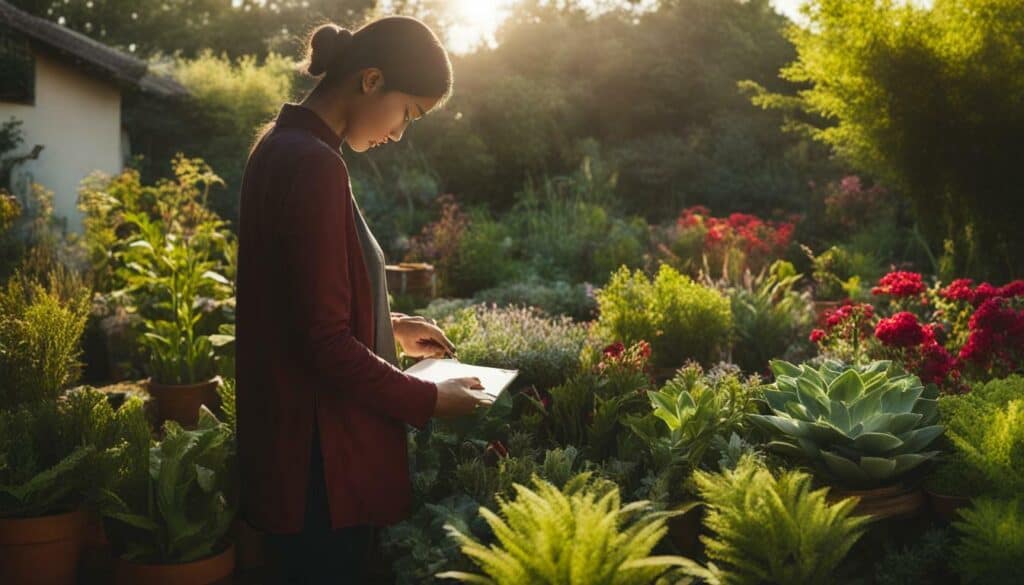
By carefully selecting the right plants for your garden, you can create a beautiful and thriving oasis that brings you joy and satisfaction. Happy gardening!
Essential Tools for Successful Garden Planting
Having the right tools is essential for smooth and efficient garden planting in the ground. Whether you’re a beginner or an experienced gardener, having a well-equipped toolbox can make all the difference in your gardening journey. Here are some essential tools that every gardener should have:
Garden Gloves
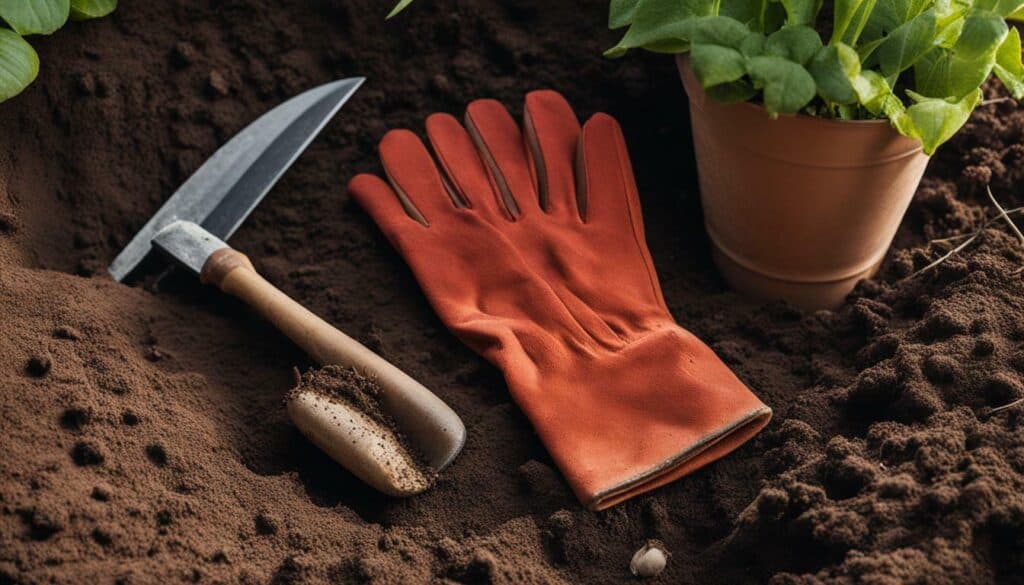
Garden gloves are a must-have for any gardener. They protect your hands from thorns, dirt, and other hazards while providing grip and dexterity for various gardening tasks. Look for gloves that are durable, comfortable, and breathable.
Trowel
A trowel is a small handheld tool with a pointed blade, perfect for digging small holes, transplanting seedlings, and loosening soil. Choose a trowel with a sturdy handle and a sharp, rust-resistant blade for optimal performance.
Garden Fork
A garden fork is a versatile tool that can be used for loosening compacted soil, turning compost, and removing weeds. Look for a fork with sturdy tines and a comfortable handle for ease of use.
Garden Hoe
A garden hoe is ideal for cultivating soil, removing weeds, and creating furrows for planting seeds. Look for a hoe with a sharp blade and a comfortable handle for efficient garden maintenance.
Pruning Shears
Pruning shears, also known as secateurs, are essential for trimming and shaping plants, removing dead or diseased branches, and harvesting fruits and vegetables. Choose pruning shears with high-quality blades that can make clean cuts.
Garden Rake
A garden rake is useful for leveling soil, removing debris, and spreading mulch. Look for a rake with sturdy tines and a comfortable handle for efficient garden grooming.
Watering Can or Hose
Proper watering is crucial for the health and growth of your plants. Invest in a watering can or a hose with a spray nozzle for efficient and controlled watering. Consider the size of your garden and the distance to water your plants effectively.
Hand Pruners

Hand pruners, also known as bypass pruners, are ideal for cutting small branches, pruning shrubs, and harvesting flowers. Look for pruners with sharp blades, a comfortable grip, and a locking mechanism for safe storage.
Wheelbarrow or Garden Cart
A wheelbarrow or a garden cart is essential for transporting heavy loads of soil, mulch, plants, and other gardening materials. Choose a sturdy and durable wheelbarrow or cart with ergonomic handles for easy maneuverability.
Hand Tiller
A hand tiller, also known as a hand cultivator, is perfect for loosening soil, removing weeds, and preparing the ground for planting. Look for a hand tiller with sharp, sturdy tines and a comfortable grip for efficient soil cultivation.
These are just a few essential tools for garden planting in the ground. Having the right tools can make gardening a more enjoyable and successful experience. Invest in high-quality tools that meet your specific gardening needs and take care of them to ensure their longevity. With these tools in your arsenal, you’ll be well-equipped to master the art of planting a garden in the ground.
Mastering the Art of Planting in the Ground: Tried-and-True Techniques
Mastering the proper planting techniques is key to ensuring the healthy growth and development of your garden plants. When it comes to planting a garden in the ground, there are several tried-and-true techniques that every gardener should know. These techniques will help you achieve optimal plant growth and a thriving garden. Here are some essential tips:
Proper Spacing
One of the most important aspects of planting in the ground is ensuring proper spacing between plants. Each plant has specific spacing requirements, and overcrowding can lead to competition for resources and hinder plant growth. Read the seed packets or plant labels to determine the recommended spacing for each type of plant, and follow these guidelines when planting.
Correct Planting Depth
The depth at which you plant your garden plants is crucial for their success. Different plants have different planting depth requirements, so it’s important to follow these guidelines. Planting too shallowly can expose the plant’s roots and make it vulnerable to drying out, while planting too deeply can suffocate the roots and inhibit their growth. Refer to the plant labels or seed packets for the recommended planting depth for each plant.
Watering
Proper watering is essential for the success of your garden plants. When planting in the ground, it’s important to water the plants thoroughly after planting to settle the soil and ensure good root-to-soil contact. Afterward, monitor the soil moisture regularly and water the plants whenever the top inch of soil feels dry. Deep, infrequent watering is generally more effective than frequent, shallow watering, as it encourages the plants to develop deep root systems.
Weeding and Mulching
To keep your garden beds free from weeds and to maintain optimal soil moisture levels, it’s important to weed regularly and apply mulch around your plants. Weeds can compete with your garden plants for nutrients, sunlight, and water, so removing them promptly is crucial. Applying a layer of mulch around your plants helps suppress weed growth, retain soil moisture, and regulate soil temperature.
Protective Measures
In some cases, you may need to take protective measures to ensure the survival and success of your garden plants. This can include using garden fabric or row covers to protect young plants from extreme temperature fluctuations or pest damage. Additionally, installing supports, such as stakes or trellises, can help keep tall or vine plants upright and prevent them from bending or breaking.
Regular Monitoring
Once your garden plants are in the ground, it’s important to regularly monitor their progress and make adjustments as needed. Keep an eye out for signs of nutrient deficiencies, pest infestations, or diseases, and take appropriate action to address these issues. Regular monitoring allows you to catch problems early and prevent them from spreading or causing significant damage.
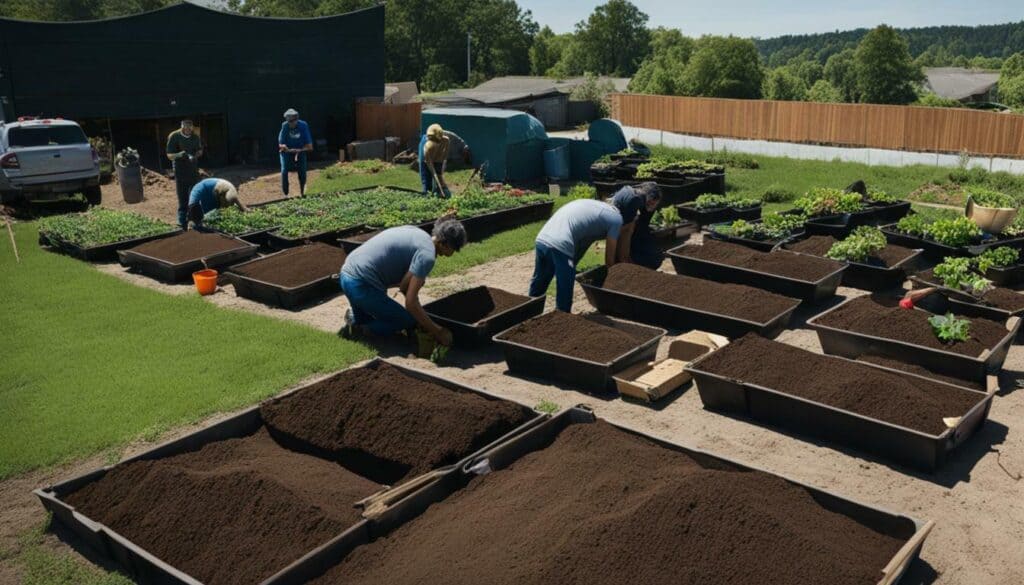
By mastering these tried-and-true planting techniques, you can set yourself up for success and enjoy a thriving garden in the ground. Remember to follow the specific planting recommendations for each plant, provide proper spacing, water adequately, and take protective measures when necessary. With a little care and attention, your garden will flourish and reward you with a bountiful harvest.
Garden Maintenance Tips for a Thriving Garden
Maintaining a garden requires regular care and attention to keep your plants healthy and thriving. Here are some essential garden maintenance tips to help you achieve a vibrant and productive garden.
1. Watering
Proper watering is crucial for the success of your garden. Provide your plants with the right amount of water, depending on their needs. Check the moisture level of the soil regularly and adjust your watering schedule accordingly. It’s best to water your garden in the early morning or late afternoon to minimize evaporation.

2. Weeding
Weeds can compete with your plants for nutrients, water, and sunlight. Regularly remove weeds from your garden to prevent them from taking over. Use a garden hoe or hand tools to carefully remove weeds from the root.
3. Mulching
Applying a layer of mulch around your plants helps retain moisture, suppress weed growth, and regulate soil temperature. Choose organic mulch, such as wood chips or straw, and spread it evenly around your garden beds.
4. Pruning and Trimming
Pruning and trimming your plants help promote healthy growth and maintain their shape. Remove dead or diseased branches, trim overgrown foliage, and shape your plants to encourage bushier growth.
5. Fertilizing
Provide your plants with the necessary nutrients by fertilizing them regularly. Use organic fertilizers to enrich the soil and promote healthy plant growth. Follow the instructions on the fertilizer package for the appropriate application method and dosage.
6. Pest Control
Monitor your garden for pests and take appropriate measures to control them. Use organic pest control methods, such as companion planting, natural predators, or organic insecticides, to protect your plants from pests while minimizing harm to beneficial insects.
“A well-maintained garden is a reflection of the care and love you invest in your plants.”
7. Disease Prevention
Prevent the spread of diseases in your garden by practicing good sanitation and hygiene. Remove and dispose of diseased plant material, clean your gardening tools regularly, and avoid overcrowding plants to improve air circulation.
8. Regular Inspection
Regularly inspect your plants for any signs of problems such as pests, diseases, or nutrient deficiencies. Early detection and intervention can prevent further damage and help preserve the health of your garden.
9. Harvesting
Harvest your crops at the right time to enjoy their peak flavor and quality. Follow the recommended harvesting guidelines for each plant, and handle your produce carefully to avoid bruising or damage.
10. Garden Cleanup
At the end of the growing season, clean up your garden by removing dead plants, clearing debris, and preparing the soil for the next season. Proper garden cleanup helps prevent the buildup of pests and diseases and prepares your garden beds for future planting.
By following these garden maintenance tips, you can create a thriving and beautiful garden that will bring you joy and abundance throughout the year.
Maximizing Your Garden’s Yield: Harvesting and Preserving
Harvesting your garden’s produce at the right time and preserving it properly ensures that you can enjoy the fruits of your labor for months to come. Whether you have a small backyard garden or a large plot of land, maximizing your garden’s yield is a rewarding endeavor. Here are some tips and techniques for harvesting and preserving your garden’s bounty.
Harvesting Tips
Knowing when to harvest your crops is crucial for ensuring optimal taste and quality. Each vegetable and fruit has its own unique harvesting requirements. Here are some general guidelines:
- Observe the color and texture: Many vegetables and fruits change color or become firm when they are ready for harvest. For example, tomatoes should have a deep, vibrant color and be slightly soft to the touch.
- Check the size: Take note of the recommended size for harvest. For instance, zucchini is best when harvested at a smaller size, while winter squash should be allowed to fully mature on the vine.
- Use a harvesting knife or shears: Invest in a sharp, clean tool specifically designed for harvesting. This will ensure clean cuts and minimize damage to the plant.
- Harvest in the morning: Plants are typically more hydrated in the morning, which can help maintain the freshness and flavor of harvested produce.
Remember to harvest regularly to encourage continuous production. Some vegetables, like beans and cucumbers, will produce more if regularly harvested.
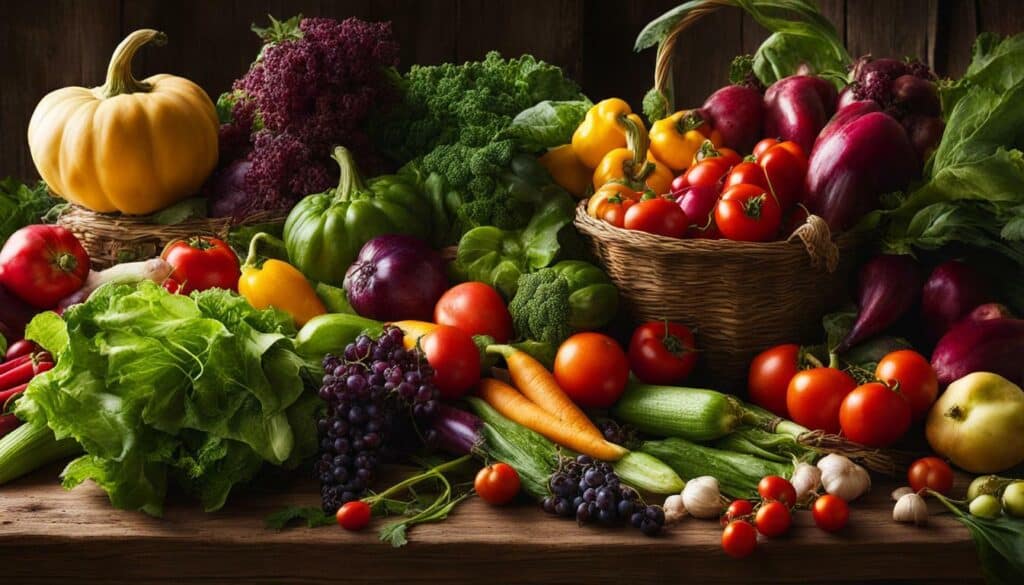
“Harvesting your garden’s produce at the right time and preserving it properly ensures that you can enjoy the fruits of your labor for months to come.”
Preserving Techniques
Preserving your garden’s harvest allows you to enjoy homegrown produce long after the growing season ends. There are various methods of preservation to choose from:
- Canning: Canning is a popular method for preserving fruits, vegetables, and even sauces and soups. It involves placing the food in glass jars and sealing them to create a vacuum. This process extends the shelf life of the food.
- Freezing: Freezing is a convenient and simple way to preserve garden produce. Most fruits and vegetables can be blanched and then frozen for later use. Freezing maintains the color, texture, and flavor of the produce.
- Drying: Drying is a traditional method of preserving food that removes the moisture from the produce. It can be done using a food dehydrator or by air drying. Dried fruits and vegetables can be stored for an extended period.
Each preservation method has its own unique requirements and considerations. Research the specific techniques and equipment needed for the method you choose.
Storage Tips
Proper storage is key to preserving the quality of your garden’s harvest. Here are some storage tips to keep in mind:
- Remove any damaged or spoiled produce: One rotten fruit or vegetable can quickly spoil the entire batch.
- Store in the right conditions: Different fruits and vegetables have different storage requirements. Some need to be stored in the refrigerator, while others do best at room temperature.
- Consider using root cellars or cold storage: Root cellars provide a cool, dark, and humid environment that is ideal for storing crops like potatoes, carrots, and onions.
- Label and date your preserved produce: Proper labeling ensures that you can identify the contents and the date of preservation, helping you use them in a timely manner.
By implementing these harvesting, preserving, and storage techniques, you can make the most of your garden’s yield and enjoy the flavors of your homegrown produce all year round.
Remember, gardening is a rewarding journey that takes time and effort, but the satisfaction of growing and enjoying your own fresh produce is unparalleled. So get out there, tend to your garden, and reap the rewards of your hard work!
Cultivating a Sustainable Garden: Composting and Organic Practices
Cultivating a sustainable garden not only benefits the environment but also contributes to the long-term health and productivity of your plants. By embracing organic practices and incorporating composting into your gardening routine, you can create a thriving and eco-friendly garden that will yield bountiful harvests year after year.
The Benefits of Composting
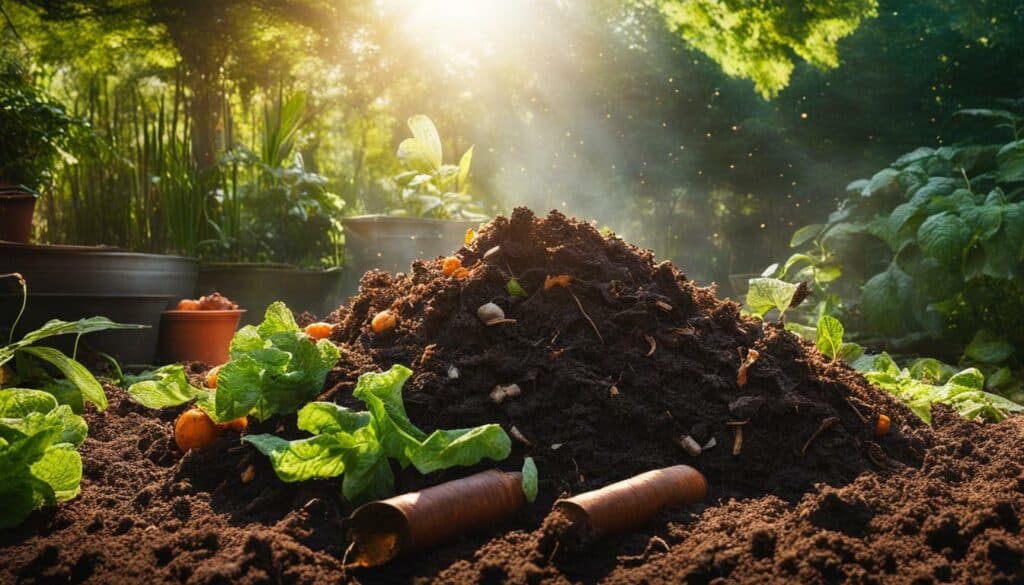
Composting is a natural process that transforms organic materials into nutrient-rich compost. By composting kitchen scraps, yard waste, and other organic matter, you can create a valuable soil amendment that improves soil structure, enhances moisture retention, and provides essential nutrients for your plants.
Compost not only enriches the soil, but it also helps suppress plant diseases and pests, reduces the need for synthetic fertilizers, and promotes beneficial soil microorganisms. It is a sustainable alternative to chemical fertilizers and a key component of organic gardening.
Getting Started with Composting
To start composting, you’ll need a compost bin or pile in a convenient location in your garden. Choose a container or area that allows for proper airflow and drainage. A compost bin with a lid or cover helps retain heat and moisture, speeding up the decomposition process.
Add a mixture of “green” and “brown” materials to your compost. Green materials include vegetable scraps, fruit peels, coffee grounds, and grass clippings. Brown materials include dry leaves, straw, wood chips, and shredded paper. Layer these materials to create a balanced compost pile.
Regularly turn or mix your compost pile to ensure proper decomposition and prevent odor or pest problems. Keep the pile moist but not waterlogged to maintain the ideal conditions for decomposition.
Within a few months to a year, depending on environmental conditions and the materials used, your compost will transform into dark, crumbly, nutrient-rich humus that can be added to your garden beds to improve soil fertility and structure.
Other Organic Gardening Practices
Composting is just one aspect of organic gardening. Here are some other practices to consider:
- Use organic fertilizers, such as compost or well-rotted manure, to provide the necessary nutrients for your plants.
- Avoid synthetic pesticides and herbicides, opting for natural alternatives or integrated pest management techniques.
- Encourage beneficial insects and pollinators by planting a diverse range of flowering plants.
- Practice crop rotation to prevent the buildup of pests and diseases in your garden beds.
- Implement proper irrigation techniques, such as drip irrigation or soaker hoses, to conserve water and reduce evaporation.
Conclusion
Cultivating a sustainable garden through composting and organic practices is not only beneficial for the environment but also for the long-term health and productivity of your plants. By incorporating these practices into your gardening routine, you can create a thriving and eco-friendly garden that will provide you with a bountiful harvest year after year.
Embracing the Art of Ground Planting: A Rewarding Journey
Planting a garden in the ground is a rewarding journey that allows you to connect with nature, enjoy the freshest produce, and create a beautiful and thriving outdoor space. Whether you are a seasoned gardener or a beginner, mastering the art of planting a garden in the ground is an essential skill that will enhance your gardening experience. In this final section of our article, I will summarize the key takeaways and highlight the rewarding aspects of ground planting.
Connecting with Nature
Planting a garden in the ground provides a unique opportunity to connect with nature on a deeper level. As you dig your hands into the earth, feel the soil between your fingers, and witness the growth and transformation of your plants, you can develop a profound sense of connection and appreciation for the natural world. Ground planting allows you to observe the intricate web of life, from the buzzing bees pollinating your flowers to the earthworms enhancing soil fertility.
Enjoying Fresh and Flavorful Produce
One of the greatest rewards of planting a garden in the ground is the ability to enjoy the freshest and most flavorful produce. When you grow your own fruits, vegetables, and herbs, you have complete control over their cultivation, ensuring that they are free from harmful chemicals and pesticides. The taste of a homegrown tomato or the aroma of freshly picked herbs cannot be matched by store-bought alternatives. Ground planting gives you the opportunity to savor the true essence of each plant and experience the joy of harvesting and eating what you have nurtured.
Creating a Beautiful Outdoor Space
Planting a garden in the ground allows you to transform your outdoor space into a beautiful oasis. By selecting the right plants, arranging them thoughtfully, and incorporating design elements such as paths, trellises, and decorative accents, you can create a visually stunning garden that reflects your personal style. Ground planting offers endless possibilities for creativity, from designing a vibrant flower bed to cultivating a lush vegetable garden. The beauty of a well-tended ground garden can be enjoyed by both yourself and others, creating a welcoming and inspiring environment.
Building a Sense of Accomplishment
Mastering the art of planting a garden in the ground is a journey that requires dedication, patience, and ongoing learning. As you witness the growth and success of your plants, you will experience a deep sense of accomplishment and pride. From the first seed sown to the first harvest, each milestone achieved in your ground garden brings a sense of satisfaction and fulfillment. The process of nurturing and tending to your plants instills a sense of responsibility and connection with the natural world, fostering personal growth and a sense of achievement.
Planting a garden in the ground is a journey filled with rewards. It allows you to connect with nature, enjoy the freshest produce, create a beautiful outdoor space, and build a sense of accomplishment. Whether you are a seasoned gardener or just starting out, ground planting offers a wealth of opportunities for personal growth, creativity, and connection. So grab your tools, prepare your soil, and embark on the rewarding journey of planting a garden in the ground.
FAQ
Q: What is the importance of mastering the art of planting a garden in the ground?
A: Mastering the art of planting a garden in the ground is important because it allows for a deeper connection with the earth and nature. It also provides the opportunity to grow a wide variety of plants and experience the satisfaction of successfully nurturing them.
Q: How do I prepare the soil for a successful garden?
A: To prepare the soil for a successful garden, start by removing any weeds or grass from the planting area. Then, till the soil to loosen it and remove any rocks or debris. Add organic matter, such as compost or aged manure, to improve the soil’s fertility and drainage. Finally, smooth the soil surface and create raised beds or rows for planting.
Q: What are some essential tools for garden planting?
A: Some essential tools for garden planting include a shovel or spade for digging, a rake for leveling the soil, a garden trowel for planting seedlings, and a watering can or hose for watering. Other useful tools include a garden fork, a hoe, and a hand cultivator.
Q: How can I maximize my garden’s yield through proper harvesting and preserving?
A: To maximize your garden’s yield, harvest vegetables and fruits when they are at their peak of ripeness. Use sharp garden shears or pruners to safely and cleanly cut the produce from the plant. After harvesting, properly store and preserve the produce through methods such as canning, freezing, or drying.
Q: What are some sustainable gardening practices to embrace in a garden?
A: Some sustainable gardening practices to embrace include composting to reduce waste and provide nutrient-rich soil, using organic fertilizers and pest control methods to avoid harmful chemicals, and planting native and pollinator-friendly plants to support local ecosystems.
Q: What are some tips for maintaining a thriving garden?
A: Some tips for maintaining a thriving garden include regular watering, proper weeding to remove unwanted plants, monitoring for pests and diseases, and providing support for plants that need it. It’s also important to regularly inspect the garden for any issues and address them promptly.
Q: How can I choose the right plants for my garden?
A: To choose the right plants for your garden, consider factors such as your climate, sunlight exposure in your garden, and personal preferences for types of plants and flowers. Research which plants are well-suited to your region and growing conditions for the best chance of success.
Q: What are some tried-and-true planting techniques for a successful garden?
A: Some tried-and-true planting techniques for a successful garden include properly spacing plants to allow for proper growth and airflow, planting at the correct depth, and watering thoroughly after planting. It’s also important to follow the specific planting instructions for each type of plant or seed.

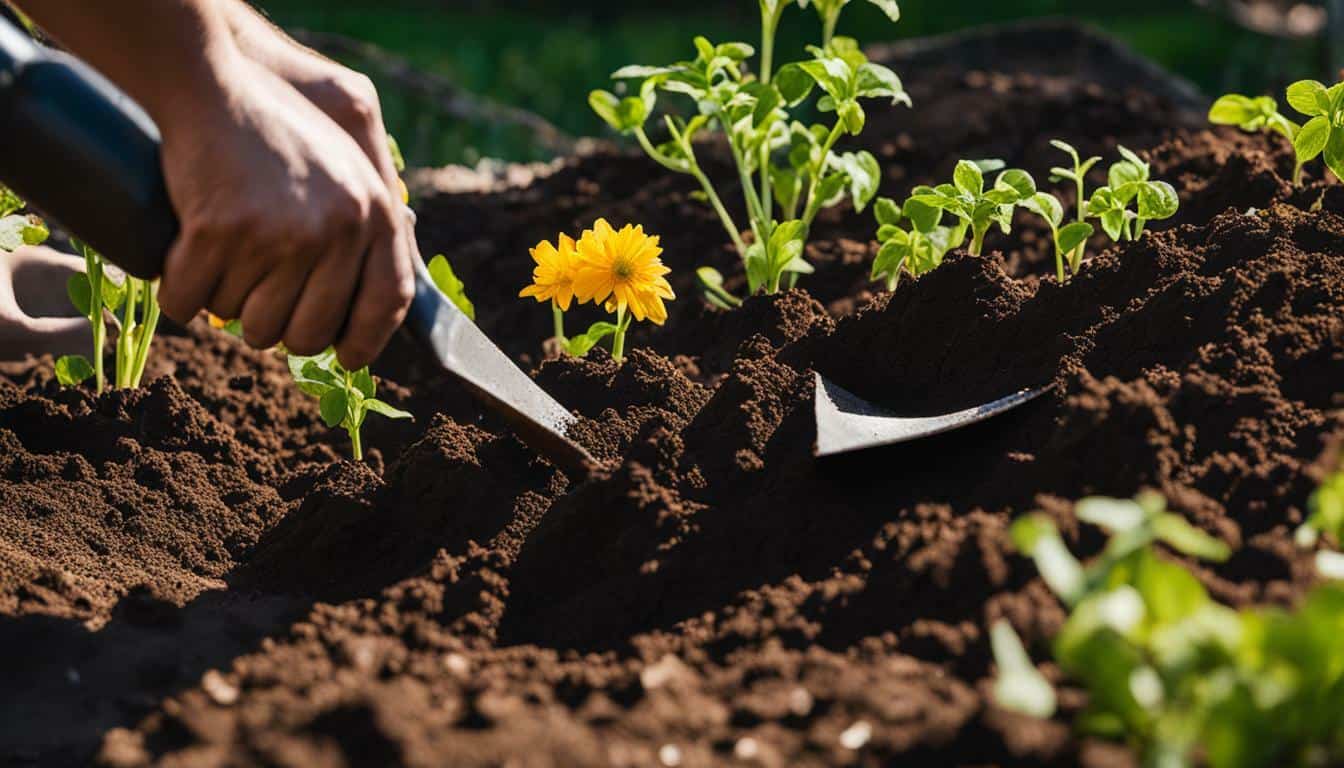



Leave a Reply